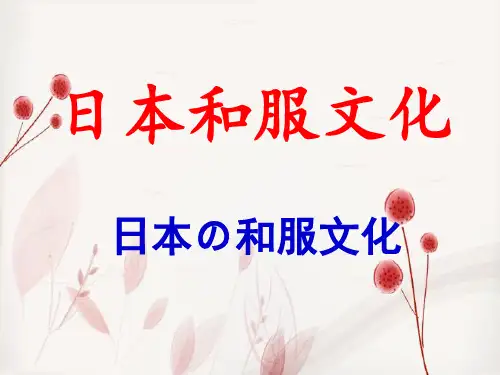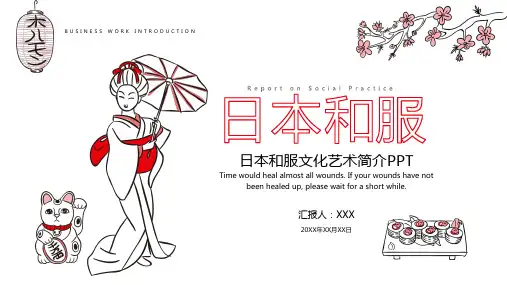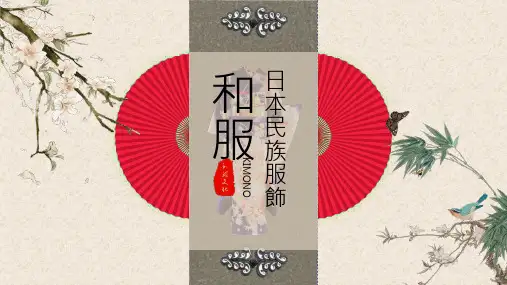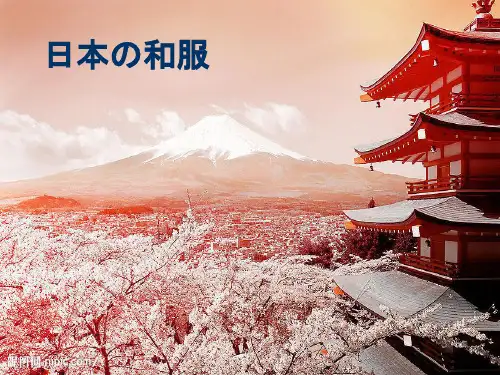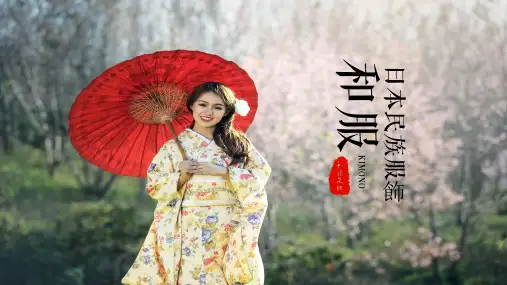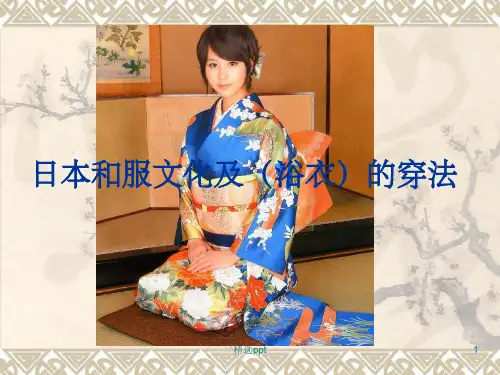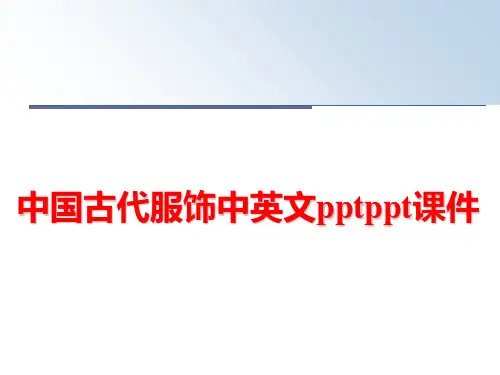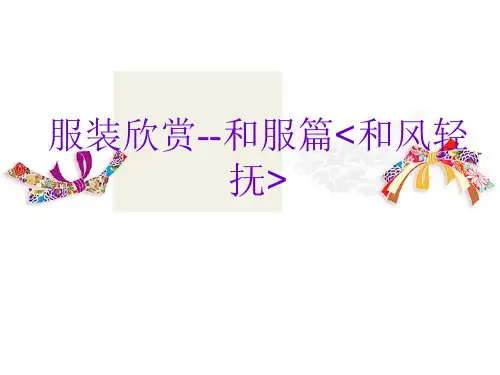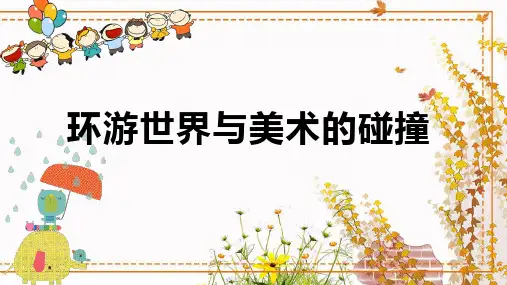- 1、下载文档前请自行甄别文档内容的完整性,平台不提供额外的编辑、内容补充、找答案等附加服务。
- 2、"仅部分预览"的文档,不可在线预览部分如存在完整性等问题,可反馈申请退款(可完整预览的文档不适用该条件!)。
- 3、如文档侵犯您的权益,请联系客服反馈,我们会尽快为您处理(人工客服工作时间:9:00-18:30)。
Welcome to Japanese Kimono!
It’s been a long time since Japanese people began wearing western style’s garments in their daily lives. But kimono, the Japanese traditional clothes are not something what can be left behind.
浴衣(ゆかた)
Women's Kimono - Yukata
In the summer, many women wear a yukata, a light-weight cotton kimono, to attend festivals. Most yukata are navy blue and white, but girls and young women sometimes wear brightly colored, floral pattered yukata. Some people wear them around the house. Japanese inns and hot spring resorts often provide yukata for guests to wear in their rooms.
Children's Kimono
What Is Kimono?
Kimono=着物(きもの)
Kimono means something to wear in Japanese. Specifically, kimono refers to traditional Japanese clothes (kimono dresses).
Hakama, which may look like a skirt in this photograph, are actually a pair of pleated pants, worn over a kimono. Hakama are worn today on formal occasions, and are also used in the practice of the traditional martial arts such as Aikido(合気道), Kendo (剣道) and archery.
Women's Kimono - Sleeve Design
The sleeves of the kimono indicate the age and marital status of a woman. A young unmarried woman would wear a furisode(振袖ふりそで:长袖和服), a colorful kimono with flowing sleeves that hang almost to the ankles. The Furisode, made of of chirimen(縮緬ちり めん:皱绸) and decorated by yuuzen(友禅ゆうぜ ん:〈纺〉友禅绸), is appropriate to wear on formal and ceremonial occasions, such as weddings.
Men's Kimono
A man usually wears a conservatively styled kimono of blue, black, brown, gray, or white.
Men's Kimono- Obi
A man's obi is narrow, and tied in a simple knot, in contrast to a woman’s obi.
十二単(じゅうにひとえ): 宫廷妇女的一种礼服
武官束帯(ぶかんそくたい)
采女(うねめ)
水干(すいかん)
汗衫(かざみ)
Poster of the movie “a thousand year love’’
紫の上:紫姬
Hale Waihona Puke Muromachi Period (1192-1573 A.D.) 室町時代
Edo Period (1601-1867 A.D.) 江戸時代
The Kimono Pattern Parts
The kimono pattern consists of four main strips of fabric. Two patterns form the panels covering the body and two panels for the sleeves. Additional smaller strips form the narrow front panel and collar.
Kimono in History
The illustration to the right shows how kimono design has changed over the centuries.
From the primitive Jomon(縄文) period through the Yamato(大和), Asuka(飛鳥), Nara(奈良), Heian(平安), Muromachi(室町), and Edo(江戸) periods, factors including climate, life and customs of the Imperial court, laws, the development of skills in weaving and dyeing, and the availability of materials have influenced the style of Japanese clothing. Today , 1200 years later, the Imperial household still uses the costumes of the Heian period (平安時代)for the formal occasions of coronations and weddings.
羽織(はおり)
Men's Kimono - Haori
A formal kimono can be worn with a haori jacket as well as the hakama. The haori is held closed with a braided cord tied in a decorative knot. Today this type of outfit is mostly worn for very formal occasions, most commonly by the bridegroom during his wedding ceremony.
In contrast, a married woman wears a kimono with a short sleeve.
Women's Kimono - Obi
帯(おび)
An obi is the sash tied around a kimono. It can be tied in a variety of simple and elaborate ways. An obi may be as wide as one foot and as long as 13 feet. Some complicated styles may take as long as half an hour to tie. A simple obi to be worn on less formal occasions, typically by a married woman.
In the martial arts, it is said that the seven pleats of a hakama represent the seven virtues of bushido(武士道) which are: ❖Gi(義) --the right decision ❖Yu (勇)-- bravery ❖Jin(仁) -- universal love, benevolence toward mankind; compassion ❖Rei(礼) -- right action, courtesy ❖Makoto(誠) -- sincerity, truthfulness ❖Meiyo(名誉) -- honor ❖Chugi(忠義) -- devotion, loyalty
Children's Kimono
Kimono for children are shaped and styled much like those for adults, but are almost always in bright patterns and prints. Children typically wear fancy kimono for special festivals and visits to local shrines on holidays.
Kimono is perhaps one of Japan’s most beautiful treasure. I would like to share with you the beauty of the Japanese kimono.
content
What Kimono Is The Kimono Pattern Parts Kimono in History Women's Kimono Men's Kimono
Rose Obi Butterfly Obi Flower Obi Seasonal Flower Obi Simple Obi
